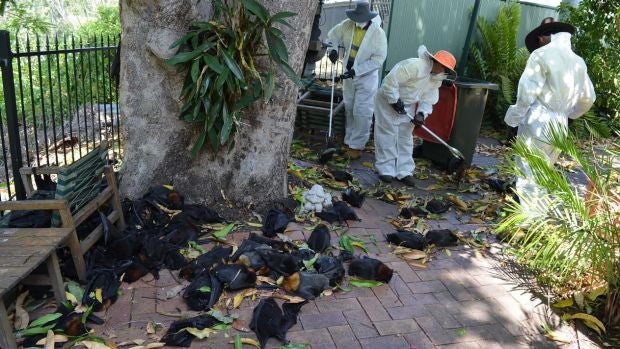The unintended consequences of pumping heat-trapping carbon dioxide into the atmosphere 10 times faster than the previous 66 million years are heatwaves.
Heatwaves in Australia are becoming hotter by 1.8 to 3.6F, longer from three days to more than six days and more frequent. All Australian capital cities, where the majority of the people live, are at risk from the increasing severity and intensity of heatwaves and catastrophic firestorms.
It’s not just the elderly, children and outdoor workers who are at immediate risk. The latest massive heatwave that spread across huge swathes of eastern Australia killed thousands of flying foxes. From Adelaide, South Australia, to North Coast, New South Wales, these exquisite pollinators and insectivores fell out of trees and perished from heat exhaustion.

Richmond Valley Council workers removing dead bats on Tuesday morning following the weekend heatwave.
According to my colleague Dr Sarah Perkins-Fitzpatrick at the University of New South Wales, Sydney: “Usually you would only get this kind of extreme heat if it was an El Nino summer. The most recent El Nino phenomenon ended in mid 2016.”
Man-made heat, infused into the oceans from climate-altering fossil fuels, has doubled since 1997. That’s the equivalent energy of detonating one atomic Hiroshima-style bomb every second for 75 straight years.
Last Friday, the North Pole was 50F above normal as warm tropical air descended in the area above 80 latitude, the Arctic Circle. It’s the third heatwave this winter. In the past, Arctic heatwaves have been recorded once or twice a decade. The Arctic was missing a staggering area of sea ice in January. It’s a record-breaking area, equivalent to roughly two times the size of France.
The exposed Arctic Ocean is pumping latent heat into the polar atmosphere, which in part, is affecting the polar jet stream as it is meandering farther south than normal. In December 2015, that wandering polar jet stream was implicated in torrential flooding in the UK, the worst on record.
This year, extreme weather brought floods and frost into Spain’s Murcia Region that supplies approximately 80 percent of certain types of produce to the UK during the winter. Fields of millions of lettuce, broccoli, zucchinis and eggplant were ruined. As a result, the UK experienced shortages on some supermarket shelves, causing the price of romaine lettuce to soar by 300 percent.
Meanwhile in the US, a strong Pacific jet stream dropping mega amounts of precipitation onto California and stressing its aging dams, i.e. Oroville, has also been shoving mild Pacific air down slope onto the Southern Rockies and eastward across the lower half of the nation. Over the weekend, temperatures in some parts of America resembled those of July rather than February. On Friday, Denver, Colorado: 80F, Saturday, Magnum, Oklahoma: 99F, and Sunday, Norfolk, Virginia: 82F.
Trees (including food-bearing trees and shrubs) from New Mexico to Virginia and southward to the Gulf of Mexico responded by flowering and leafing three weeks ahead of time. They are now at risk for frost damage, which could jeopardize the US fall food supply.
Heatwaves and other extreme weather as well as dying honeybees are a wake-up call for global food security.
It’s time to end all fossil fuel subsidies immediately and follow China’s $370 billion (USD) investment in creating 13 million new jobs in the renewable energy sector.
The only way to contend with the climate in crisis is to tackle it head on. Not to subsidize the biggest, wealthiest polluters to hasten the planet’s demise.
At the end of the day, it’s about survival and preventing our planet from becoming inhospitable. We require 80 percent renewable energies by 2030 and 100 percent by 2050.
#ResistRejectDenial
Earth Doctor Reese Halter’s upcoming book is “Save Nature Now.”
